SMU Data and Models

Key Market Indicators Looking Up
Written by Peter Wright
January 30, 2018
Steel Market Update publisher, John Packard, traded comments with a financial analysts who was of the opinion that demand was under duress and the future of the steel using markets was in doubt. This does not match our belief based on a review of the SMU Key Market Indicators. We are sharing this report with both our Executive and Premium users (normally it just goes to our Premium clients) as evidence in our conviction that we are in a good steel market environment.
The trends of major key market indicators are the best they have been since Steel Market Update first performed this analysis in January 2010. Data released in January shows that 47.2 percent of the 36 indicators are historically positive with only 19 percent negative. The balance is within the band of historically normal. The total of positive and normal has not changed in six months. However, there have been frequent changes in the detail. Trends improved with 83.3 percent of the indicators heading in a positive direction, up from 61.1 percent in October and from 72.2 percent in November. Trends lead the present situation by about four months.
See the end of this piece for an explanation of the Key Indicators concept. This will explain the difference between our view of the present situation, which is subjective, and our analysis of trends, which is based on the latest facts available. The total number of indicators considered in this analysis is 36.
Refer to Table 1 for our view of the present situation and the quantitative measure of trends. Readers should regard the color codes in the present situation column as a visual summary of the current market condition. The “Trend” columns of Table 1 are also color coded to give a quick visual appreciation of the direction the market is headed. All data included in this table was released in January. The month or specific date to which the data refers is shown in the second column from the far right. All results are the latest available as of Jan. 31, 2018.
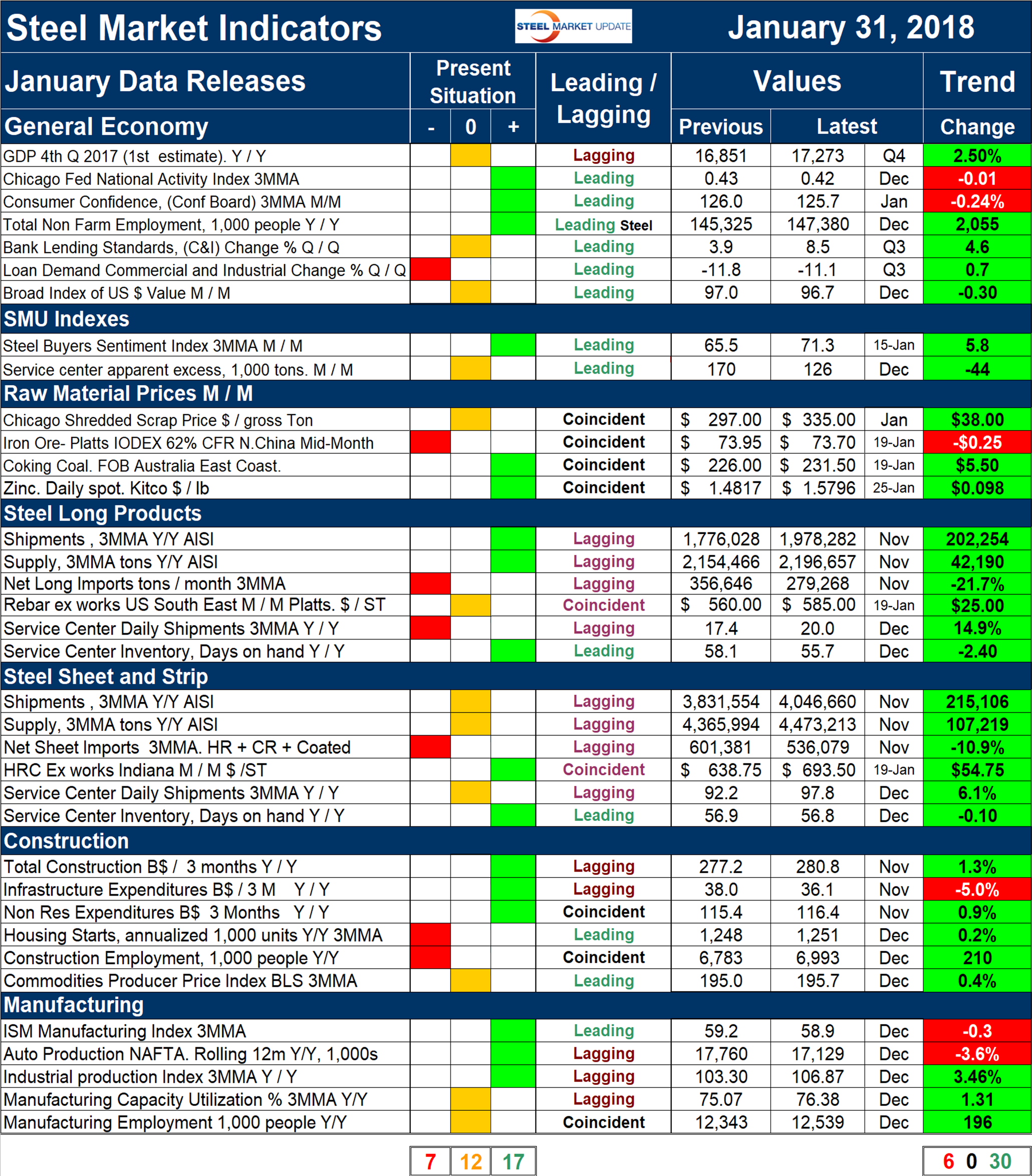
Present Situation
There was no change in our perception of the balance of indicators in January between negative, neutral and positive, and there were no changes in the detail. We currently view 17 of the 36 indicators as positive, 12 as neutral and 7 as negative. Our intent in using the word neutral is to say that this indicator is considered to be in the mid-range of historical data. Figure 1 shows our monthly assessment of the present situation since January 2010 on a percentage basis. The indicator classification has been remarkably consistent for the last 11 months with the combination of positive and neutral indicators being above 80 percent for 10 of those months. This is the best string of results since we first performed this analysis.
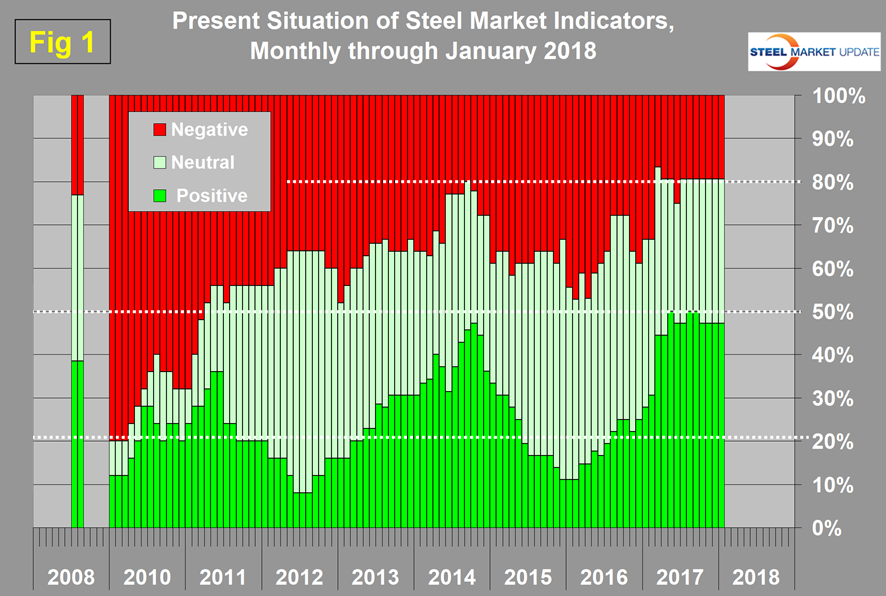
Trends
Most values in the trends columns are three-month moving averages (3MMA) to smooth out what can be very erratic monthly data. Trend changes in the individual sectors since the end of December data are described below together with some general comments. (Please note in most cases this is not January data but data that was released in January for previous months.)
Figure 2 shows the trend of the trends and the pre-recession situation at the far left of the chart. The proportion of trends that are improving is now the highest since this analysis was first performed in January 2010 and equal to the level in March 2017.
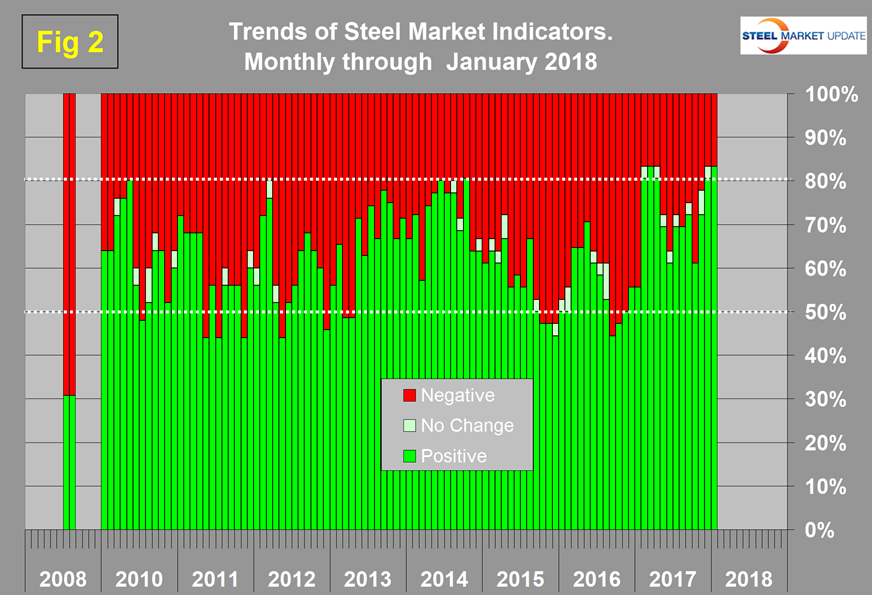
Our observations about trends in the January data are as follows: In the General Economy section of Table 1, there were three tend reversals. The Chicago Fed National Activity Index and Consumer Confidence both took a small retrograde step from levels that were historically very high. (Consumer confidence actually improved in January, but the 3MMA declined). The Broad Index of the U.S. dollar declined, which we regard as a positive move because of the effect on net trade. One of the SMU indexes reversed direction. Service center excess of sheet products declined in the December data. This is a proprietary SMU calculation. We regard an inventory deficit to be positive in terms of pricing power. In December, the surplus declined from 170,000 tons to 126,000 tons (Figure 3). Historically, this is very close to zero, therefore we are presently in a situation of negotiation neutrality.
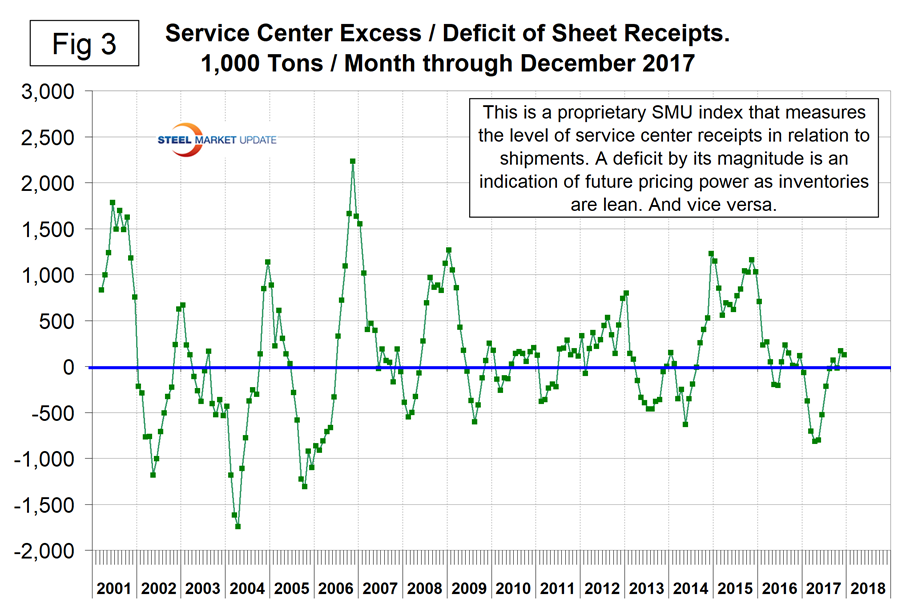
Steel buyers’ sentiment continued to strengthen through mid-January after revering direction in December. Sentiment is historically very high (Figure 4). There was one trend reversal in raw materials prices following the December situation when all were rising. We regard rising raw materials prices as positive and indicative of a strengthening market. In January, the price of coking coal took a step back as buyers remained on the sidelines.
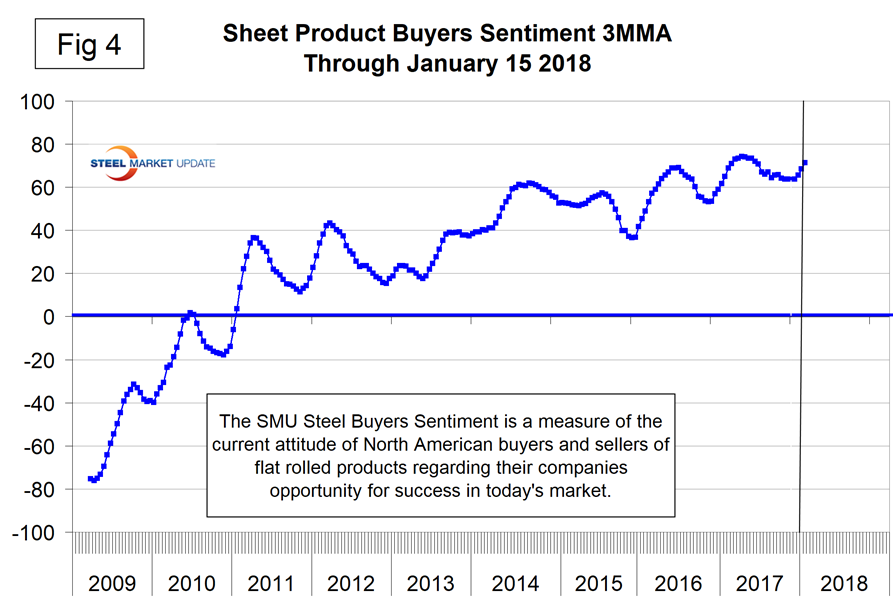
In the long steel products sector, the price of rebar was unchanged in December but continued its upward trajectory in January. As a result, all long product indicators are now trending positive. In the sheet section, all indicators are also trending positive, which was no change from our December update. In the construction sector, there were no trend reversals. Five of the six indicators are trending positive. The only negative continues to be infrastructure expenditures, which have trended negative since our February update. In the manufacturing sector, three of the five indicators are trending positive, which was no change from our last update. Auto production in NAFTA contracted for the fourth straight month, and the ISM index contracted very slightly but is still at a very high level.
We believe a continued examination of both the present situation and direction is a valuable tool for corporate business planning.
Explanation: The point of this analysis is to give both a quick visual appreciation of the market situation and a detailed description for those who want to dig deeper. It describes where we are now and the direction the market is headed, and is designed to describe the situation on a specific date. The chart is stacked vertically to separate the primary indicators of the general economy, of proprietary Steel Market Update indices, of raw material prices, of both sheet and long product market indicators, and of construction and manufacturing indicators. The indicators are classified as leading, coincident or lagging as shown in the third column.
Columns in the chart are designed to differentiate between where the market is today and the direction it is pointing. Our evaluation of the present situation is subjectively based on our opinion of the historical value of each indicator. There is nothing subjective about the trends section, which provides the latest facts available on the date of publication. It is quite possible for the present situation to be predominantly red and trends to be predominantly green or vice versa depending on the overall situation and direction of the market. The present situation is subdivided into, below the historical norm (-), (OK), and above the historical norm (+). The “Values” section of the chart is a quantitative definition of the market’s direction. In most cases, values are three-month moving averages to eliminate noise. In cases where seasonality is an issue, the evaluation of market direction is made on a year-over-year comparison to eliminate this effect. Where seasonality is not an issue, concurrent periods are compared. The date of the latest data is identified in the third values column. Values will always be current as of the date of publication. Finally, the far right column quantifies the trend as a percentage or numerical change with color code classification to indicate positive or negative direction.

Peter Wright
Read more from Peter WrightLatest in SMU Data and Models

SMU’s June at a glance
A look at SMU data for the month of June.

SMU Survey: Buyers’ Sentiment rebounds from multi-year low
Both of SMU’s Steel Buyers’ Sentiment Indices edged higher this week. Current Sentiment rebounded from a near five-year low, while Future Sentiment rose to a two-month high

SMU flat-rolled market survey results now available
SMU’s latest steel buyers market survey results are now available on our website to all premium members.

SMU Survey: Sheet lead times pull back after early-June blip, plate holds
Following the uptick seen two weeks ago, lead times eased this week for all four sheet products tracked by SMU, while plate lead times held steady, according to this week’s market survey.

SMU Survey: Pricing power abruptly shifts to steel buyers
The majority of steel buyers responding to our latest market survey say domestic mills are more willing to talk price on sheet and plate products than they were earlier this month. Sheet negotiation rates rebounded across the board compared to early June, while our plate negotiation rate hit a full 100%.
